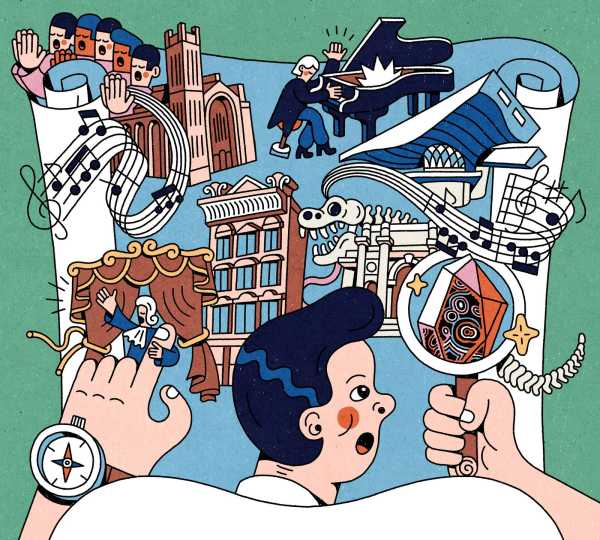
Save this storySave this storySave this storySave this storyYou’re reading the Goings On newsletter, a guide to what we’re watching, listening to, and doing this week. Sign up to receive it in your inbox.
On the occasion of our third centenary issue—this one culture-themed—we asked our writers to share one of their most treasured cultural institutions, big or small. Whether it’s a beloved stone in a storied hall of gems and minerals, a soaring cinema in Korea, or an invaluable downtown fixture, these are places that bring inspiration, joy, and comfort.—Shauna Lyon

Illustration by Louis Otis

About Town
New York City
On your next visit to Manhattan’s American Museum of Natural History, head to the Allison and Roberto Mignone Halls of Gems and Minerals and have a look at the opals. In the Victorian era, opal got cancelled, in part, because the novelist Sir Walter Scott created a character who died while wearing one. And, O.K., opal is softer than, say, diamond, whose diabolical merchants contributed to opal’s tarnished reputation. But the stone was good enough for Shakespeare; in “Twelfth Night,” he called it the “queen of gems.” Because the opal’s structure contains water, it is susceptible to dehydration, creating “crazing,” an effect that gives only the appearance of flaws. Sign me up! Opals come in gumdrop red, kitten-nose pink. My favorites are the oceanic greens and blues, one of which reminds me of a Rothko. This is what the Earth is up to while we’re all on Instagram.—Paige Williams
Washington, D.C.
As of this summer, I’m no longer a Washington, D.C., local, but I’ll draft on the fumes of my Beltway years to recommend a perfect workspace: the Kogod Courtyard, in the National Portrait Gallery. Hardly a secret, it’s true, but the combination of light, air, and cathedral acoustics (not to mention being free to the public) is hard to beat. Kogod’s defining feature is its roof, a wavelike structure that seems to flutter like a curtain of glass over the tree boxes and a wafer-thin reflecting pool created by Kathryn Gustafson. (Norman Foster designed the atrium.) There’s an ambient hum of conversation that I haven’t found distracting; if anything, the reverberant quality of people’s voices makes the space feel pure and pensive. But, for true head-down days, the Luce Center on the third floor offers gratis coffee, electrical outlets galore, and pristine quiet.—Katy Waldman
New York City
On the northwest corner of a Hundred and Fourteenth Street and Broadway, next to a Starbucks and down the block from a primary school, rests the pocket-sized Broadway Presbyterian Church. Unlike its sprawling neighbor, Riverside Church, a few streets over, Broadway Presbyterian stands humbly on a fraction of sidewalk, with a mere four stairs leading up to its fire-engine-red doors. But inside is a vibrant sanctuary for classical music. Radial pews of dark wood sit below stained-glass windows and contemporary art; performances range from Baroque standards to new modern jewels. The church frequently hosts concerts by Music for Food, an initiative dedicated to combatting food insecurity: admission is free, but donations go to Broadway Community, a local organization that serves those experiencing homelessness and poverty in New York City. Small church, big impact.—Jane Bua
Busan, South Korea
The Busan Cinema Center, in the seaside city of Busan, South Korea, is one of the great architectural wonders of the moviegoing world. During my occasional trips to the Busan International Film Festival, I have spent many happy hours wandering around the center—a wild modernist colossus, designed by the Austrian firm Coop Himmelb(l)au. My fondest memory is of one fall night in 2018, at the center’s outdoor theatre—sitting there shivering in the chilly night air, staring up at an enormous undulated ceiling studded with rainbow-hued L.E.D. lights, before the crowd fell silent for a piano performance by the great Ryuichi Sakamoto, an honoree that year. There are certainly warmer, more comfortable venues to see a movie, but few others so powerfully project the notion of cinema as a destination, or imbue the act of watching a film with such a spirit of grandeur.—Justin Chang
New York City
Much of New York City’s boom-period performance topography has been demolished and snazzified—CBGB is a fancy shoe shop now, and House of Candles is a restaurant. But La Mama, founded in 1961, seems only busier, brighter, and stronger: what was once Ellen Stewart’s performance “club” (so-called to get around uptight municipal rules) has grown into a beautiful, Escheresque complex on East Fourth Street. One day, standing in the lobby, a door I had never noticed opened, and I saw into Narnia: the theatre’s overflowing, maze-like treasury—a stunning fifty-year archive that includes pearl-draped costumes, enormous wooden-jointed puppets, letters from theatre royalty, set pieces from the city’s experimental heyday. La MaMa’s founding archivist, the much beloved Ozzie Rodriguez, passed away this July, but his long stewardship of the city’s performance history lives on—and, unlike Narnia, his magic kingdom is available to anyone who makes an appointment.—Helen Shaw
A New Yorker Quiz
It was a big week for beloved musicians; test your knowledge about these performers.
Which megawatt pop star announced her engagement this week? Hint: “She’s such a good songwriter,” Jia Tolentino wrote in 2016, “never letting a syllable fall out of place.”
Which K-pop group hit No. 1 on Billboard’s Hot 100? Hint: the band is actually a fictional headliner from a movie that also includes, as Kyle Chayka writes, “cutesy animal sidekicks, binges of instant ramyeon, anime stylization, and ass-kicking action sequences.”
Which rock-and-roll legend celebrated fifty years since his landmark album? Hint: “He remains dispiritingly handsome,” David Remnick notes, “preposterously fit.”
P.S. Good stuff on the internet:
- Birds of a feather
- New York’s great trees
- How to be happy, according to Jemima Kirke
Sourse: newyorker.com







